For the last week, presidential and vice presidential candidates for SGA have plastered the campus with fliers and gone door-to-door soliciting votes from fellow students. Despite the clear effort put forth by these students, the short campaigning period hampers the possibilities for substantive differences to emerge between candidates.
Currently, candidates for SGA Executive positions have only one week to formally apply whether or not to run and then only one week to actually campaign. This is insufficient. Election Board should extend both the application window and, even more importantly, the campaigning period.
With only a week to campaign, the main way students learn about the candidates is through brief bathroom readers and loggia posters often featuring merely a candidate’s name and a photo ripped from Facebook. These are too frequently low on content and high on gimmicks such as unreasonable promises to reform the dining hall. Crunched for time, it’s understandable that candidates resort to these tactics as they must perform publicity triage, allocating their resources to simply get their name out to all of campus rather than engage in meaningful debate.
The open forum scheduled during the campaign week could serve as good venues to highlight policy differences between the candidates but coming only two days after the campaign begins, it affords candidates little time to prepare. With such a short window to publicize events, students at large also have little time to research the issues or the candidates but, further, might not even be aware of the fact that an election is at hand.
What emerges are overly vague and homogenous campaign statements with each candidate touting similar qualifications and pushing ambiguous claims to increase communication and transparency.
A longer campaign would grant both candidates and students more time to research and define their platforms. If the election cycle were extended to two or three weeks, multiple public forums could be held allowing candidates to further differentiate themselves from one another.
One derivative benefit of all of this could include an actual debate between all candidates in which they are forced to defend and evaluate their own policies and those of their opponents. A five-minute sound byte at a poorly attended open forum is insufficient to distinguish between candidates.
These increased differences could be furthered through enhanced coverage in open forums such as KDIC and the S&B. With only a week-long campaign, we at the S&B don’t have time to fully investigate and report on the candidates and their issues. A longer campaign timeframe would allow us to further differentiate the candidates with our own reporting supplementing the debate and open forum.
This is not an indictment on the quality of the candidates and their campaigns. The current system constrains their ability to create and clearly express their ideas.



















































